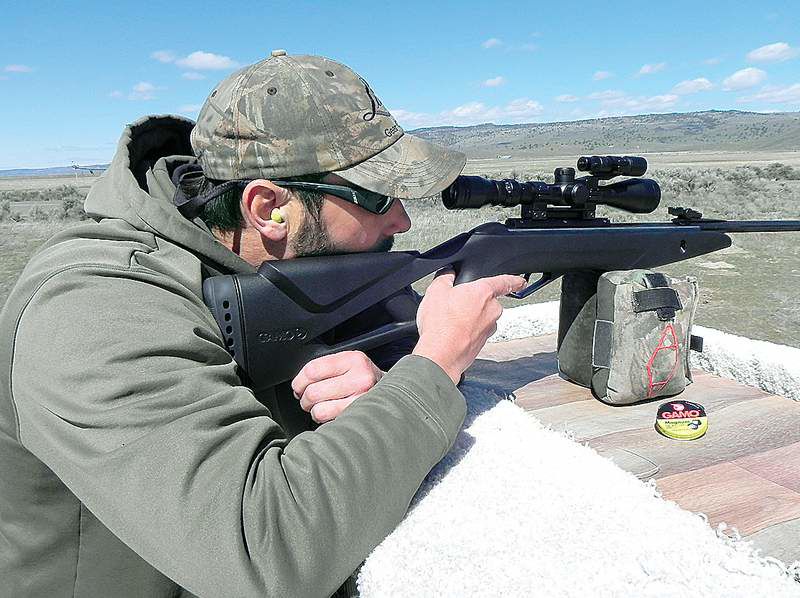Air-rifle hunting
Published 5:00 am Thursday, May 5, 2011

- Jim Milton, of Bend, shoots the Gamo Whisper VH, a .177-caliber break-action air rifle.
Quiet, Jim Milton pointed his truck into the field, the engine at idle. We push-clicked the doors closed and placed jacks under the shooting platform with a minimum of commotion.
Up on top, we could see for miles in every direction. Gray-brown ground squirrels perched atop huge dirt mounds and their worn trails ran like the spokes of a wheel into the two-inch orchard grass.
Hundreds of yards away, white PVC pipes baited with tempting tasties and blood thinner offered the ground squirrels a slow demise. It did not appear to be working. Belding’s ground squirrels, also called sage rats in Eastern Oregon, scampered in and out of the white pipes. Without us to help, the farmer would not have much left to take to market.
During the months of April and May, my friends Nikki and Justin Aamodt, owners of Diamond A Guides, operate farmland varmint hunts to solve the problems created by the proliferation of ground squirrels. It has become a spring ritual to spend a day or two with them at their camp at Crystal Crane Hot Springs.
This time, Rex Allison, his 12-year-old son Ethan and 15-year-old Sam King were along to help. To start close, to keep from spooking varmints farther out, we uncased the air rifles.
Over the last 10 years, air guns have undergone a quiet evolution. Benjamin, Crosman, Gamo and other brands are in a race to bring us better ammunition, better optics, higher velocities, quieter operation, minimized recoil and quick follow-up shots.
In the last few weeks, I’ve tested three new air rifles. I had hoped to try the new Benjamin Rogue, but they are hard to come by right now. The Rogue caught my imagination when I heard that Nosler had developed a .357-caliber bullet for the new air rifle. Suitable for hunting deer and wild hogs at close range, the Rogue is a multi-shot repeater with a microprocessor controlled valve that allows the hunter to extend the accuracy (and lethality) out to an advertised 100 yards. The eVALVE furnishes electronically driven power for as many as 20 shots per fill.
First to arrive at my doorstep were the .25-caliber Benjamin Marauder and the Crosman Optimus, a break-barrel .177-caliber with a four-power scope.
The pre-charged pneumatic Marauder is sophisticated, accurate and quiet, with velocities greater than 850 feet per second and 45 foot-pounds of kinetic energy per shot. It offers a dual fuel option for either compressed air or CO2 and a built-in pressure gauge to display the gun’s charge level.
The futuristic Gamo Whisper VH is black with a skeletonized synthetic stock, topped by a 3×9 scope, a laser (not legal for hunting in Oregon) and an LED light. It shoots a premium lead-free pellet at an advertised 1,200 fps and standard lead pellets at 1,000 fps.
Out in the field, we tested the Whisper VH alongside the Optimus. After a short break-in, both guns shot quieter than brand new.
When I handed the rifle to Jim Milton, our guide, he found a target and settled in for a shot. The gun coughed. Downrange, the impact of the Gamo pellet sent a tiny trail of dust into the breeze. He adjusted for the range and compensated for the wind to score a hit on his next squeeze.
Over the next eight hours, we took turns and marveled at how quiet an 8-gram chunk of lead or lead-free alloy could be delivered with precision out to 35 yards or so.
On the racks of sporting goods stores, four main calibers are offered: .177, .20, .22 and .25 caliber. Most common are the .177 and .22. If the primary pests and protein sources are small and feathered, the .177 might be the best choice. That little pill delivered at up to 1,600 feet per second is a proven performer. If an occasional rat, snake or squirrel might be contemplated as a target, the .177 is still a worthy option.
If, on the other hand, the pest in question is furred, a .22 caliber brings the energy to put woodchucks, rock chucks, jack rabbits, opossums and other small-game animals down for good.
A firing range and backstop can be built in a basement or garage. The practice is good training for big-game hunts and, outside of city limits, an air rifle can be used to dispatch unwanted varmints without alarming the neighbors. With the .357 Rogue and the Nosler bullet, the day has come when coyotes, hogs and deer can be dispatched with air power.
You could call it an arms race. The consumer, with more air power options than ever, is the winner.






